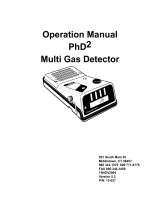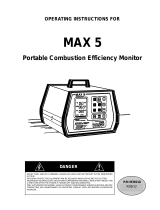
-3-
CALIBRATION PROCEDURE
Do not use inert gases to zero the monitor. This will cause premature failure of the sensor.
CO Zero Adjustment
To zero the instrument, follow the steps below. Zero calibration gas should be used to properly “zero” the
instrument and assure that a valid calibration is achieved. If zero adjustment cannot be made as indicated, sensor
replacement may be necessary. After each monitor adjustment outlined in the following steps, allow time for the
changes to stabilize.
Note: A controlled orifice in the
regulator will allow the gas to flow
at approximately 300 cc/min.
6. Attach the clear tubing with male plug to the monitor
air sample inlet.
7. Open gas regulator fully by turning the knob at least
two (2) turns counterclockwise.
8. Allow digital readout to stabilize approximately 15 -
30 seconds.
9. Adjust "zero" pot adjustment screw (clockwise to
increase, counterclockwise to
decrease) until a "00" reading
is obtained.
10. Turn off the regulator and disconnect the tubing from
the zero air regulator.
1. Place the “on/off/test” switch to the “on” position.
2. Allow 30 seconds for the readout to stabilize.
The green indicator light will illuminate.
3. Hold the “on/off/test” switch in the “test”
position. The following will occur:
• Audible alarm will sound
• Green indicator LED will flash
• Amber low battery indicator
LED will illuminate
• Red lamp on
This test ensures the circuitry is operable and the
continuity to the sensor is proper. Release the switch.
4. Remove air sample inlet tube.
5. Install regulator on the zero air cylinder reference gas.





